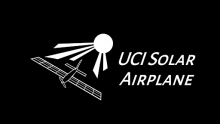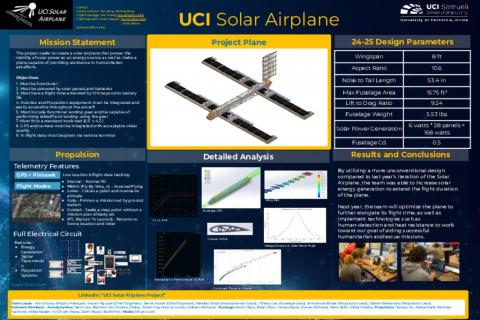UCI Solar Airplane (2024-2025)
Our purpose:
The purpose of the UCI Solar Airplane project is to prove the viability of solar energy as a substitute for nonrenewable fuel and to provide aid in search and rescue missions during natural disasters where drones and other methods would not be effective. Climate change has progressed at an alarming rate, especially in recent years, making it evident that a drastic change in energy use is necessary. Even so, today’s most commonly used energy source globally is still fossil fuels. While the renewable energy market continues to expand, it is vital to concentrate efforts into promoting applications of clean energy.
The Solar Airplane team works to prove that solar energy is a viable alternative to fossil fuels in aviation in hopes that it will spur an increase in solar energy applications for other energy needs as well. Our project will conducts extensive research into solar panels and aviation to produce a product that can benefit the future of our planet and its people. The plane itself will have a lengthened flight time by utilizing solar panels to charge its batteries. Our efforts in achieving a successful flight will not only prove the versatility and effectiveness of solar energy, but it will also be a large step forward in addressing the climate crisis.
This school year (2025-2026), the Solar Airplane project fabricated a remote-controlled plane using easily attainable materials and readily available solar panel technology. By improving upon the project’s previous iterations, we aimed to attain a design to prove the efficiency and ease of integration that solar energy can offer. In the future, as technology constantly evolves, the team will continue researching building materials, solar panels, and electrical components. Additionally, we plan to implement a camera providing FPV footage in order for the plane to perform its duties as a search-and-rescue UAV. The project conducts research solely with the intent to improve sustainability and humanitarian efforts. It is our hope that one day, our efforts will reach a mass audience and spur an era of sustainably powered aviation.
Design Requirements:
- Must be functional
- Must be powered by solar panels and batteries
- Must have a flight duration extended by 10% beyond the battery life
- Electronics and Propulsion equipment must be integrated and easily accessible throughout the aircraft
- Must fit in a standard truck bed (6.5’ x 4.2’)
- GPS and camera must be integrated with acceptable video quality
- In-flight data must be given via remote terminal
Team Structure:
Fuselage Sub-team
The fuselage sub-team’s primary responsibility is to research, design, and fabricate the main body of the aircraft. This is composed of the frame and internal loading structures, skin of the plane, wingbox, tail connection, and the landing gear. In order to contribute to the plane’s overall success, the sub-team will take into account factors such as weight, center of gravity, structural integrity, and aerodynamic performance. Construction of the main body will be completed in collaboration with the aerodynamics team in order to incorporate the wings and tail. Additionally, the fuselage sub-team will cooperate with the propulsion team to integrate electrical components, which will be housed in the fuselage.
Aerodynamics Sub-team
The aerodynamics sub-team’s primary responsibility is to research, design, and fabricate the wings, tail, and control surfaces of the plane. The aerodynamics sub-team will be split into two groups that work closely together: the wing team and the tail team. To optimize the performance of the plane, the aerodynamic sub-team will take into account the wing and tail shape, size, placement, material, and their effect on the overall plane’s center of gravity. In addition, the sub-team will determine the placement and design of the control surfaces on the wings and tail, which will determine the plane’s trajectory.
Propulsion
The propulsion sub-team is responsible for researching, designing, and fabricating the control system of the aircraft, as well as effectively powering the plane. The propulsion sub-team is split into two groups: energy and avionics.
- The energy team researches and implements the solar panels to efficiently deliver power to the airplane. Additionally, this team is responsible for selecting a motor, propeller, and battery that can provide enough thrust to propel the plane forward.
- The avionics team is responsible for implementing the electronic system used for flight control, navigation, and camera integration. The sub-team will use the Pixhawk flight control system and its online program, Ardupilot, to access live GPS tracking, first person viewing (FPV), and flight telemetry data.
Socials:
LinkedIn: https://www.linkedin.com/company/uci-solar-airplane-project/
Instagram: http://www.instagram.com/ucisolarairplane/
Contacts:
Faculty Advisor: Yun Wang - yunw@uci.edu
Project Manager: Ann Duong - duongha@uci.edu



